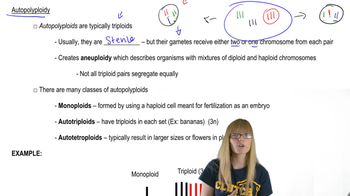Here are the essential concepts you must grasp in order to answer the question correctly.
Polyploidy
Polyploidy refers to the condition where an organism has more than two complete sets of chromosomes. In chrysanthemums, the chromosome numbers being multiples of nine indicate different levels of polyploidy, such as diploid (2x), triploid (3x), tetraploid (4x), etc. This genetic feature often affects traits like size and fertility.
Recommended video:
Basic Chromosome Number (Monoploid Number)
The basic chromosome number (x) is the number of distinct chromosomes that make up a single complete set. For chrysanthemums, x = 9, meaning all varieties have chromosome counts that are multiples of nine. This helps classify their ploidy level and understand their genetic makeup.
Recommended video:
Sterility in Triploids
Triploid organisms (3x) often exhibit sterility because their odd number of chromosome sets leads to irregular pairing during meiosis. This results in unbalanced gametes, preventing successful reproduction. The sterile chrysanthemum variety with 27 chromosomes (3x9) exemplifies this phenomenon.
Recommended video:





